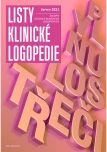BONN STUTTERING THERAPY – INTENSIVE INPATIENT INTERVAL THERAPY IN GERMANY FOR ADOLESCENTS AND ADULTS
Authors:
Müller Thilo 1; Co-Authors:; Prü Holger 2; Richardt Kirsten 3
Published in the journal:
Listy klinické logopedie 2021; 5(1): 16-23
Category:
Hlavní téma
Summary
Bonn Stuttering Therapy is stationary interval therapy for adolescents and adults. In addition to reducing the subsequent psychosocial problems by learning modification and fluency shaping techniques, this combination approach also includes comprehensive measures for transfer support and relapse prevention. The individual therapy modules are presented and their implementation is explained. The superior effectiveness of this patient-oriented therapeutic approach is proven by a survey of the long-term therapeutic effects in linguistic and personal terms. In terms of organisational form and duration of treatment, Bonn Stuttering Therapy is a unique offer of therapy in Germany, which is primarily intended for severe and severely affected stutterers.
Keywords:
stuttering – disturbance of speech fluency – Bonn Stuttering Therapy – young people and adults – combination approach – patient-oriented – BLESS
Zdroje
- APA (1994). Diagnostic and statistical manual of mental disorders. Washington, DC: American Psychiatric association.
- BAUMGARTNER, S. (2012). Sprechwerkzeuge stottern nicht. Forum Logopädie. 26(2), 6-11.
- BLOODSTEIN, O.; BERNSTEIN RATNER N. (2008): A handbook on stuttering. 6. Aufl., Clifton Park, Delmar.
- BREITENFELDT, D. & LOTENZ, D. (2002). Stotterer-Selbst-Management-Programm. Das Trainingsprogramm mit der „Ankündigung als Entlastungsstrategie für jugendliche und erwachsene Stotterer. Köln: ProLog.
- DECHER, M. (2011). Therapie des Stotterns. Ein Überblick über aktuelle Therapieansätze für Kinder, Jugendliche und Erwachsene. Köln: Demosthenes.
- DRUCKER, P. (1998). Die Praxis des Mangements. Düsseldorf: Econ.
- ELLIS, A. (1989). Die rational-emotive Therapie: das innere Selbstgespräch bei seelischen Problemen und seine Veränderung. München: Pfeiffer.
- FEHM, L. & WITTCHEN, H.-U. (2005). Konfrontationsbehandlung bei Sozialer Phobie. In: NEUDECK, P. & WITTCHEN, H.-U. (Hrsg.). Konfrontationstherapie bei psychischen Störungen: Theorie und Praxis. S. 47-66. Göttingen: Hogrefe.
- GRAWE, K., DONATI, R. & BERNAUER, F. (1994). Psychotherapie im Wandel: Von der Konfession zur Profession. Göttingen: Hogrefe.
- GREGORY, H. H. (2003). Stuttering Therapy: rationale and procedures. Boston: Allyn & Bacon.
- GUITAR, B. (1998). Stuttering. An integrated approach to its nature and treatment. Baltimore: Lippincott Williams & Wilkins.
- HAM, R. (1986). Techniques of Stutterthing Therapie. Englewood Cliffs, N. J.: Prentice-Hall.
- HAM, R. (2000). Techniken in der Stottertherapie. Köln: Demosthenes.
- HANSEN, B. & IVEN, C. (2010). Diagnostik des Stotterns bei Kindern: Ein Diskussionsbeitrag zur Umsetzung der ICF. Sprachheilarbeit. 55(2), S. 71-78.
- KUHR, A. (1991). Die verhaltenstherapeutische Behandlung des Stotterns. Berlin: Springer.
- MCCAULEY, R. (1996). Familiar strangers: criterion-referenced measures in communication disorders. Language, Speech and Hearing Services in Schools. 27, S. 122-131.
- MURRAY, F. (1993). Zu einem freieren Sprechen. In: HOOD, S. (Hrsg.). An einen Stotterer. S. 35-39. Köln: Demosthenes.
- NATKE, U. & Alpermann, A. (2010). Stottern: Erkenntnisse, Theorien, Behandlungsmethoden. Bern: Huber.
- PRÜSS, H. (1992) In: GROHNFELD, M. (Hrsg.). Was ist „Erfolg“ in der Stottertherapie? Sprachheilarbeit. 37, S. 227-239.
- PRÜSS, H. (1996). Eine autobiographische Betrachtung meiner Auseinandersetzung mit dem Problemkreis Stottern – der Weg zu einem dualistischen Grundverständnis. In: GROHNFELDT, M. (Hrsg.). Lebenslaufstudien und Sprachheilpädagogik. S. 181-203. Dortmund: Modernes Lernen.
- PRÜSS, H. & RICHARDT, K. (2010). Patientenorientierte Vorgehensweise in der Therapie des Stotterns im Jugend- und Erwachsenenalter. In: IVEN, C. & KLEISSENDORF, B. (Hrsg.). St-t-tt-ttotttern. Aktuelle Impulse für Diagnostik, Therapie und Evaluation. S. 113-132. Idstein: Schulz-Kirchner.
- RAUSCHAN, W. & WELSCH, C. (2008). Das ABC-Modell für die Therapie des chronischen Stotterns nach dem Konfrontationsansatz. Forum Logopädie. 22(2), S. 6-10.
- RILEY, G. (1994). A stuttering severity instrument for children and adults. SSI-3. Austin: ProEd.
- SANDRIESER, P. & SCHNEIDER, P. (2008). Stottern im Kindesalter. Stuttgart: Thieme.
- SHEEHAN, J. G. (1970). Stuttering. Research and therapy. New York: Harper & Row.
- SHEEHAN, J. G. (1984). Problems in the evaluation of progress and outcome. In: PERKINS, W. H. (Hrsg.). Stuttering disorders. S. 223-240. New York: Thieme.
- SOMMER, M. (2012). Fehlstart im Gehirn. Gehirn und Geist. 3, S. 40-45.
- STARBUCK, H. (1993). Werkzeugkasten für Stotterer. In: HOOD, S. (Hrsg.). An einen Stotterer. S. 119-124. Köln: Demosthenes.
- STARKWEATHER, C. W. & GIVENS-ACKERMANN, J. (1997). Stuttering. Austin: Pro-ed.
- THUM, G. (2011). Stottern in der Schule: Ein Ratgeber für Lehrerinnen und Lehrer. Köln: Demosthenes.
- THUM, G. (2013). Sprechtechniken in der Stottertherapie. Praxis Sprache. 58(2), S. 96-101.
- Van Riper, Ch. (1986). Die Behandlung des Stotterns. Solingen: Bundesvereinigung Stotterer-Selbsthilfe.
- VON TILING, J. (2010). Die Angst vor dem Stottern und ihre Ursachen. Die Sprachheilarbeit. 55(6), S. 291-300.
- WALTER, O. (2004–2009). Exposition und Reaktionsverhinderung (Konfrontationstherapie). (24. 06. 2013) Online unter URL: www.ver haltenswissenschaft.de/Psychotherapie/Verhaltenstherapie/Exposition/exposition.htm
- WENDLANDT, W. (2009). Stottern im Erwachsenenalter: Grundlagenwissen und Handlungshilfen für die Therapie und Selbsthilfe. Stuttgart: Thieme.
- WENDLANDT, W. (2010). Abenteuer Stottern: Ganzheitliche Wege und integrative Konzepte für die Therapie und Selbsttherapie. Köln: Demosthenes.
- ZANG, J. (2010). Diagnostik in der Stottertherapie. Forum Logopädie. 24(2), S. 6-11.
- ZÜCKNER, H. (2008). Intensiv-Modifikation Stottern: Die Modifikation: Informationen für Therapeuten. Neuss: Natke.
- ZÜCKNER, H. (2012). Stottertherapie bei Erwachsenen. In: NATKE, U. (Hrsg.). Wissen über Stottern: Aktuelle Informationen für Laien und angehende Fachleute. S. 55-73. Neuss: Natke.
Štítky
Logopédia Praktické lekárstvo pre deti a dorastČlánok vyšiel v časopise
Listy klinické logopedie

2021 Číslo 1
- Gastroezofageální reflux a gastroezofageální refluxní onemocnění u kojenců a batolat
- Nech brouka žít… Ať žije astma!
- Využití hodnoticích skóre a objektivních nástrojů při léčbě astmatu
- Nový lék v arzenálu biologické terapie ložiskové psoriázy
Najčítanejšie v tomto čísle
- NEUROGENNÍ DYSFLUENCE
- VÝVOJOVÁ PORUCHA PLYNULOSTI ŘEČI V PŘEDŠKOLNÍM VĚKU – PŘÍPADOVÁ STUDIE
- BREPTAVOST? PŘEKÁŽKA I PŘÍLEŽITOST! – KAZUISTIKA
- VYHÝBAVÉ CHOVÁNÍ V KOMUNIKACI DOSPĚLÝCH OSOB S KOKTAVOSTÍ
